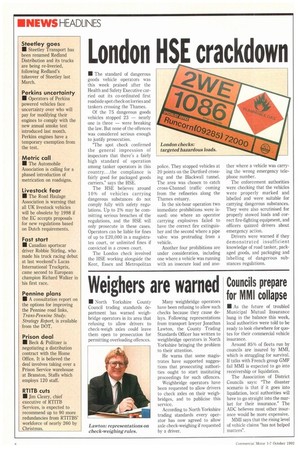London HSE crackdown
Page 8

If you've noticed an error in this article please click here to report it so we can fix it.
• The standard of dangerous goods vehicle operators was this week praised after the Health and Safety Executive carried out its co-ordinated first roadside spot check on lorries and tankers crossing the Thames.
Of the 75 dangerous goods vehicles stopped 23 — nearly one in three — were breaking the law. But none of the offences was considered serious enough to justify prosecution.
"The spot check confirmed the general impression of inspectors that there's a fairly high standard of operation among tanker operators in this country„ .the compliance is fairly good for packaged goods carriers." says the HSE.
The USE believes around 10% of vehicles carrying dangerous substances do not comply fully with safety regulations. Up to 2% may be committing serious breaches of the regulations, and the HSE will only prosecute in these cases. Operators can be liable for fines of up to £20,000 in a magistrates court, or unlimited fines if convicted in a crown court.
The London check involved the HSE working alongside the Kent, Essex and Metropolitan police. They stopped vehicles at 20 points on the Dartford crossing and the Blackwall tunnel. The area was chosen to catch cross-Channel traffic coming from the refineries along the Thames estuary.
In the six-hour operation two immediate prohibitions were issued: one where an operator carrying explosives failed to have the correct fire extinguisher and the second where a pipe valve was protruding from a vehicle.
Another four prohibitions are under consideration, including one where a vehicle was running with an insecure load and ano ther where a vehicle was carrying the wrong emergency telephone number.
The enforcement authorities were checking that the vehicles were properly marked and labelled and were suitable for carrying dangerous substances. They were also scrutinised for properly stowed loads and correct fire-fighting equipment, and officers quizzed drivers about emergency action.
Drivers were warned if they demonstrated insufficient knowledge of road tanker, packaged goods, and packaging and labelling of dangerous substances regulations.
















































































